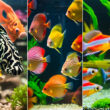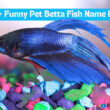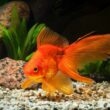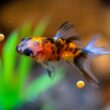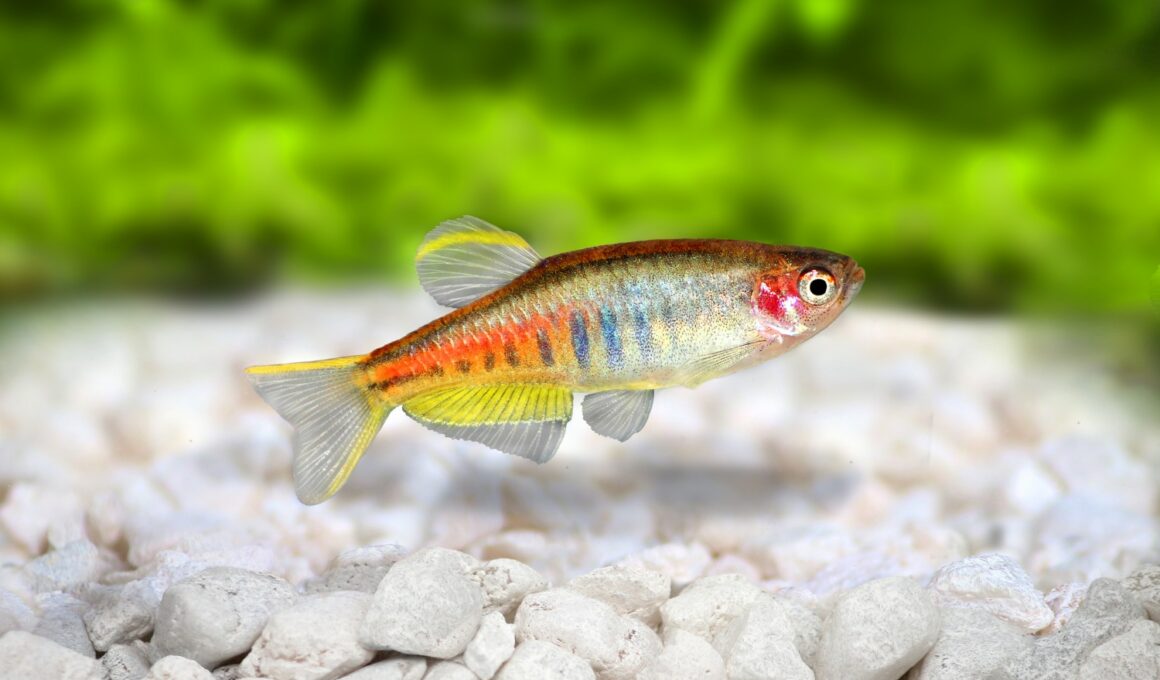In this article Show
As an aquarium enthusiast, chances are you’re either planning to bring home some Danios or are already the proud owner of these energetic little swimmers. Either way, you’ve come to the right place.
Danios are among the most popular freshwater fish in the aquarium hobby, and for good reason. They’re vibrant, social, and relatively easy to care for—making them a great choice for both beginners and experienced aquarists.
But like any pet, danios also require specific conditions to thrive. And let’s face it, thriving is what we’re aiming for, not just surviving.
In this comprehensive guide, we’ll dive into everything you need to know about danios care. We’ll talk about the ideal tank setup, the dos and don’ts of their diet, understanding their lifespan, and even some tips on breeding.
So whether you’re a novice looking for step-by-step guidance or a seasoned fish keeper looking to brush up on your knowledge, this article has something for you.
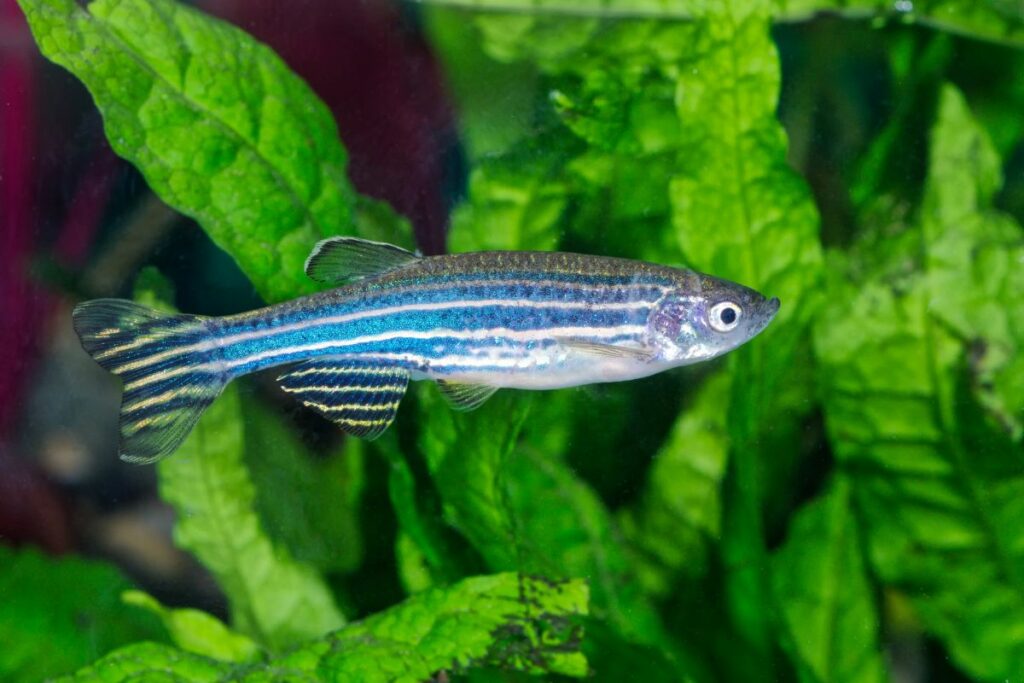
Understanding Danios
First things first, where do these vibrant fish come from? Danios are native to freshwater rivers and streams in South Asia, particularly in countries like India, Bangladesh, and Myanmar.
Their natural habitat is usually slow-moving or still water with plenty of vegetation—conditions we’ll aim to replicate in a home aquarium.
You might be surprised to learn that the term “danio” actually refers to a whole family of fish, not just one species. Some of the popular types include the Zebra Danio, Leopard Danio, and Glowlight Danio. Each has its own unique pattern and coloration but generally shares the same easy-going temperament.
General Characteristics Of Danios
So, what makes Danios tick? Here are some of their defining traits:
1. Size
Most danios grow to about 1.5 to 2 inches in length, making them a suitable choice for smaller tanks. However, don’t let their size fool you; these fish are packed with energy.
2. Color and Pattern
From stripes to spots, danios come in various patterns and colors, adding a burst of life to your tank.
3. Temperament
Danios are community fish, meaning they love company—both of their own kind and other non-aggressive species. They are quite active and are known to zip around the tank, which can be quite entertaining to watch.
4. Activity Level
These fish are most active during the day, making them diurnal. You’ll often see them swimming near the top or middle layers of the water.
Why Choose Danios for Your Aquarium
So you might be wondering, with a sea of options available (pun intended), why pick Danios? Well, there are quite a few reasons these little guys stand out in the crowd.
1. Easy to Care For
One of the most appealing aspects of Danios is their low-maintenance nature. They’re hardy fish that can adapt to a variety of water conditions, making them an excellent choice for beginners. You don’t have to be an aquarium wizard to keep these fish happy; basic knowledge and consistent care go a long way.
2. Social Behavior
If you’re looking for fish with personality, you’ve found them. Danios are incredibly social and thrive best when in a group, preferably of at least five or more. They engage in playful swimming patterns and can often be seen darting around the tank together, which adds a dynamic element to your aquarium.
3. Compatibility with Other Fish
Danios are also known for their peaceful temperament, making them compatible with a range of other non-aggressive fish species. So if you’re planning a community tank, danios could be the perfect neighbors for your other aquatic pets.
4. Aesthetic Appeal
Let’s not forget about their eye-catching appearance. Danios come in a variety of striking patterns and colors that can add vibrancy to any aquarium. Whether you prefer the classic stripes of the Zebra Danio or the iridescent hues of the Glowlight Danio, these fish are a visual treat.
5. Active and Entertaining
Last but not least, danios are just plain fun to watch. Their high energy levels and social interactions can keep you entertained for hours. They’re also curious fish that like to explore their environment, so you’ll often find them investigating every nook and cranny of your tank.
The Right Tank Setup For Danios
By now, you’re probably excited to welcome Danios into your aquatic family. But before you do, it’s essential to create a home that mimics their natural habitat as closely as possible. Here’s how to set up the perfect tank for your danios.
1. Tank Size
First and foremost, size matters—especially when it comes to your aquarium. While danios are small and could technically survive in a smaller tank, a minimum of 20 gallons is recommended. Why? Because these fish are incredibly active and need plenty of space to swim around.
2. Water Parameters
Danios are quite forgiving when it comes to water conditions, but that doesn’t mean you should be lax. Aim for the following water parameters for optimal health:
- pH: 6.0 to 8.0
- Temperature: 65 to 77°F (18 to 25°C)
- Hardness: 2 to 20 dGH
Regular testing is advised to ensure that the water stays within these ranges.
3. Substrate and Decorations
Danios aren’t particularly fussy about the substrate, but a softer one like fine sand can be more comfortable for them. As for decorations, consider adding plants, driftwood, and caves to provide hiding spots and mimic their natural environment. Just be sure to avoid any sharp or rough objects that could injure the fish.
4. Lighting and Filtration
Danios are diurnal, meaning they’re active during the day. Hence, moderate lighting is ideal. As for filtration, a basic hang-on-back filter should suffice for keeping the water clean. However, consider using a filter that provides some current, as Danios enjoys swimming against the flow.
Bonus Tip: The Cycling Process
If you’re setting up a new tank, don’t forget the essential step of cycling it before adding your fish. This process allows beneficial bacteria to develop, which helps to maintain water quality. Trust me, your Danios will thank you for it.
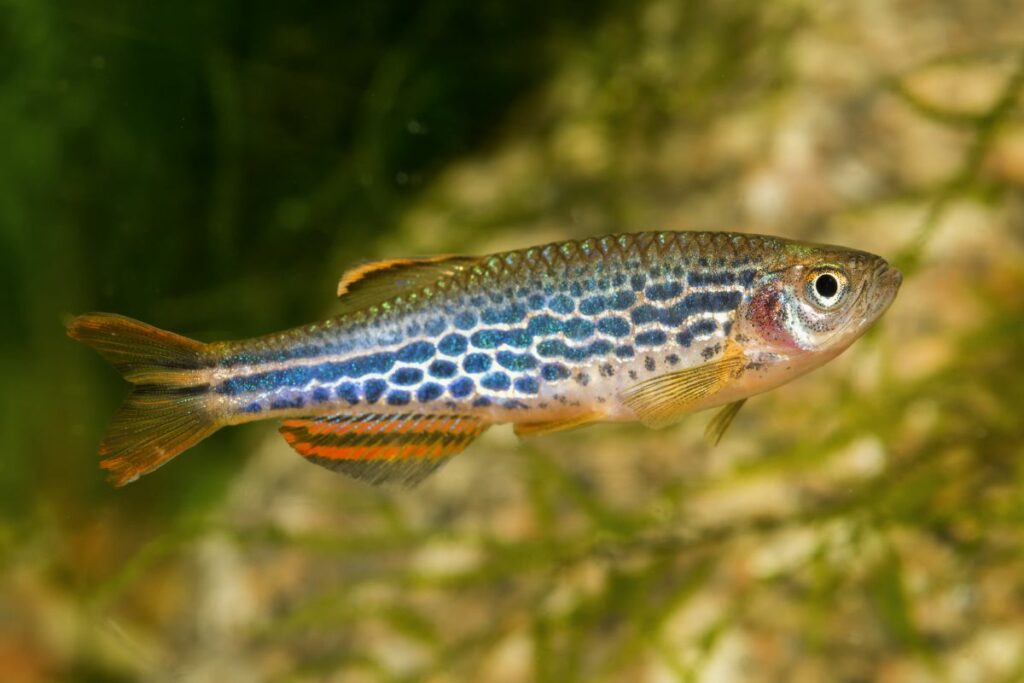
What Do Danios Eat? A Guide to Their Diet
Now that we’ve got the tank setup sorted, let’s move on to another vital aspect of Danio’s care: their diet. Understanding what to feed these energetic fish is crucial for their well-being. So, let’s break it down.
1. Types of Food Suitable for Danios
Danios are omnivores, which means they eat both plant and animal matter. Here’s a quick list of some suitable food options:
- Flake Food: High-quality flake food can serve as the staple diet for your danios. Ensure that the flakes are small enough for them to be consumed easily.
- Live or Frozen Food: To add variety and essential nutrients, consider supplementing their diet with live or frozen foods like brine shrimp, daphnia, or bloodworms.
- Vegetables: A bit of boiled and chopped zucchini, spinach, or cucumber can also be a hit with danios. Remember to remove any uneaten veggies from the tank to prevent water pollution.
2. Feeding Schedule
Danios have a fast metabolism, thanks to their high energy levels. Feeding them small portions two to three times a day is generally recommended. However, be cautious not to overfeed; a small pinch of food that they can consume in under two minutes is usually sufficient.
3. What to Avoid
Avoid low-quality flake food that lacks nutritional value. Also, be cautious with live food, as it can sometimes carry parasites. Always source from reputable suppliers to ensure you’re giving your fish the best.
Bonus Tip: Mixing It Up
Variety is the spice of life, even for your danios. A balanced diet that includes different types of food not only keeps mealtime exciting but also ensures they’re getting a range of nutrients. So don’t be afraid to mix things up a bit!
Understanding the Lifespan of Danios
So, you’ve got the tank ready and you know what to feed your danios. The next question you might have is, “How long will my finned friends be with me?” Understanding the lifespan of your pets is crucial as it helps you prepare for a long-term commitment.
Danios are relatively long-lived for small fish, typically clocking in between 3 to 5 years in a well-maintained home aquarium. However, with excellent care, some danios have been known to live up to 7 years!
Factors Affecting Lifespan
Several factors can influence how long your danios will live:
- Water Quality: Consistently good water parameters are crucial. Regular testing and water changes can help ensure a long, healthy life.
- Diet: A balanced diet that meets all their nutritional needs can significantly impact their lifespan.
- Stress: Stressful environments, often caused by overcrowding or incompatible tank mates, can lead to a shorter life.
How to Ensure a Long And Healthy Life
To maximize the lifespan of your danios, keep the following points in mind:
- Regular Health Checks: Keep an eye out for any signs of disease or discomfort, such as unusual swimming patterns, color changes, or lethargy.
- Scheduled Maintenance: Regular cleaning and filter changes are essential. A clean tank is a healthy tank.
- Peaceful Environment: Make sure your danios have enough room to swim and are kept with compatible tank mates to reduce stress.
Bonus Tip: The Importance of Quarantine
Whenever you’re adding new fish or plants to your aquarium, a quarantine period can help prevent the introduction of diseases. It’s a simple step that can make a big difference in the overall health of your tank.
Breeding Danios
After mastering the basics of danio care, some aquarists decide to take their hobby to the next level by breeding these captivating fish. If that sounds like you, you’re in for an exciting experience. Here’s what you need to know to get started with breeding danios.
1. Preparing for Breeding
Before you even think about breeding, there are a few preparations to consider:
- Selecting the Pair: Choose healthy, mature danios, typically around 6 to 12 months old. It’s best to have a group of both males and females in the tank to allow natural pairing.
- Breeding Tank: Setting up a separate tank is advisable to provide a controlled environment for breeding. The tank doesn’t need to be large; a 10-gallon setup should suffice.
- Water Conditions: Keep the water slightly warmer than usual, around 78 to 80°F (25 to 27°C), to encourage spawning.
2. Spawning Behavior
Once the stage is set, you’ll likely notice some interesting behaviors:
- Chasing: The male will typically chase the female around the tank, a clear sign that spawning is imminent.
- Egg Laying: The female will scatter eggs across the substrate or on plants. Danios are egg scatterers, which means they won’t care for their young.
3. Post-Spawning Care
After the eggs are laid, it’s important to remove the adult fish to prevent them from eating the eggs. Here’s what comes next:
- Egg Care: Danio eggs usually hatch within 2 to 3 days. No special care is needed for the eggs, but maintaining good water quality is crucial.
- Fry Care: Once hatched, the fry will start swimming in about 3 to 4 days. Initially, feed them infusoria or liquid fry food until they’re large enough to consume brine shrimp or finely crushed flake food.
Bonus Tip: Timing is Everything
The most successful breeding usually occurs early in the morning, often triggered by the first light of day. Some breeders even adjust the lighting to simulate dawn, encouraging the spawning process.
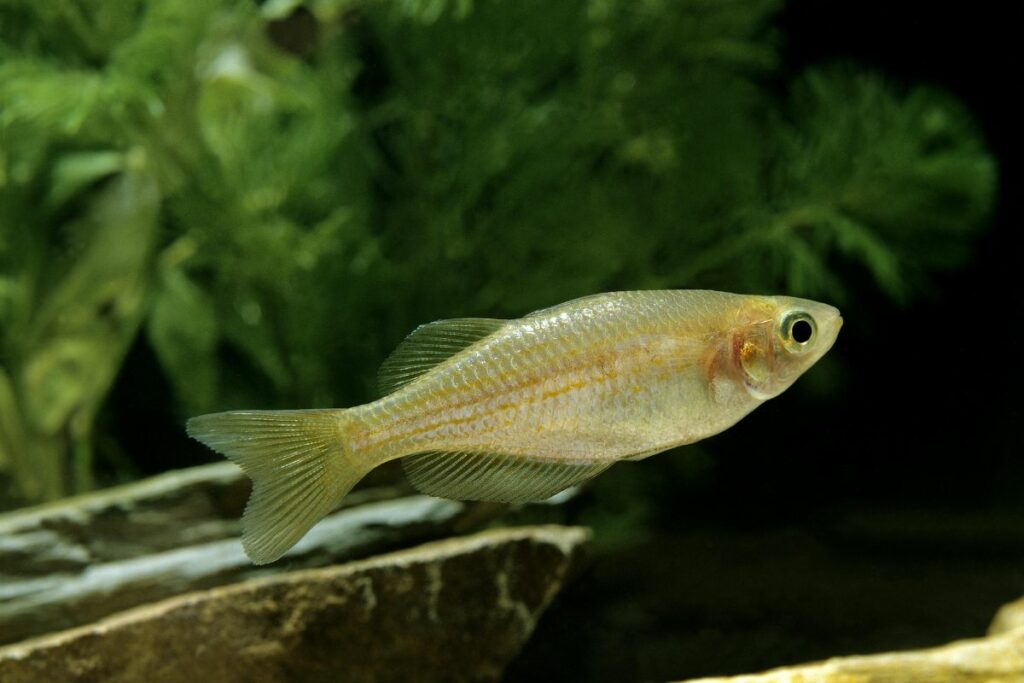
Common Health Issues and How to Address Them
Even with the best care, danios, like any pet, can face health challenges. Being proactive about recognizing and addressing these issues can make all the difference. Here’s a rundown of common health concerns and what you can do about them.
1. Ich (Ichthyophthirius Multifiliis)
The symptoms are white spots on the skin, gills, and fins; and restless swimming. Increase the tank temperature slightly to speed up the life cycle of the parasite and treat the water with an anti-ich medication available at pet stores.
2. Fin Rot
The symptom of fin rot is that the fins appear frayed or discolored, usually at the edges. Improve water quality through regular changes and use antibiotics or antifungal medications specifically designed for treating fin rot.
3. Swim Bladder Disease
Abnormal swimming patterns, including floating upside-down or leaning to one side, are the signs of swim bladder disease. Sometimes caused by overfeeding or a diet lacking in fiber, fasting the fish for a day or two and then offering a more balanced diet can help.
4. Internal Parasites
Sudden weight loss, loss of appetite, and visible protrusions from the anal area. Anti-parasitic medications are usually effective; however, consult your vet for the best course of action.
5. Stress-Related Diseases
Rapid gill movement, loss of color, hiding, or erratic swimming. Identifying the cause of stress, such as poor water quality or aggressive tank mates, and taking appropriate corrective measures is crucial.
Bonus Tip: Preventative Measures
An ounce of prevention is worth a pound of cure. Regular water testing, a well-maintained filter, and a balanced diet can go a long way in preventing most common diseases.
Additional Tips for Danios Care
By now, you’ve got a pretty solid foundation on how to care for Danios—from setting up the perfect tank to understanding their diet, lifespan, breeding, and health issues. But before we wrap up, here are some additional tips to ensure your danios thrive in their aquatic home.
- Danios are schooling fish, which means they prefer to be with their own kind. A group of at least six will help them feel secure and exhibit natural behaviors.
- While we’ve discussed feeding, remember that a diverse diet is better. Rotate between flakes, live food, and vegetables to ensure they get a full spectrum of nutrients.
- Consistency is key to a healthy aquarium. Make it a habit to check water parameters and perform weekly water changes. Your fish will thank you for it.
- A stimulating environment can improve the well-being of your fish. Try rearranging the decorations or adding new plants every once in a while to keep things exciting.
- Always keep an eye out for any changes in behavior, eating habits, or appearance. Quick action at the first sign of trouble can often prevent minor issues from becoming major problems.
Bonus Tip: Keeping a Journal
Consider keeping an aquarium journal to record water parameters, feeding schedules, and any unusual observations. It’s a great way to monitor the health and happiness of your danios over time.
Conclusion
Taking care of Danios doesn’t have to be complicated. With the right tank setup, a balanced diet, and attention to their health and well-being, these energetic fish can be a delightful addition to any aquarium.
Remember, the key to happy Danios is consistency in care and keen observation. Here’s to a tank full of vibrant, lively Danios that bring you joy for years to come!


